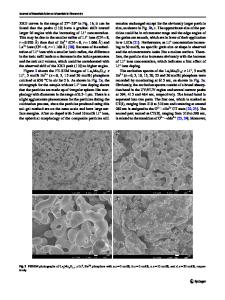Synthesis and characterization of red phosphor (Y,Gd)BO 3 :Eu by the coprecipitation method
- PDF / 406,283 Bytes
- 4 Pages / 612 x 792 pts (letter) Page_size
- 31 Downloads / 319 Views
Dojin Kim Department of Materials Engineering, Chungnam National University, Taejon 305-769, Korea (Received 6 August 2001; accepted 1 February 2002)
The synthesis and luminescent properties of (Y,Gd)BO3:Eu phosphor were investigated. A coprecipitation method was designed for preparing Eu doped (Y,Gd)BO3. This method features a low-temperature formation of single phase with semi-spherical shape compared with the conventional method. Due to the homogeneous distribution of activator, the emission intensity of the (Y,Gd)BO3:Eu phosphor prepared by the coprecipitation method is higher than the commercially available red phosphor.
I. INTRODUCTION
A plasma display panel (PDP) is considered as a candidate for flat-panel display. The future of display panel technology depends heavily on the luminous efficiency, lifetime, and color purity of phosphors. For the enhancement of phosphor efficiency, it is necessary to be advanced in both a new host material and synthetic technique.1,2 Nowadays, (Y,Gd)BO3:Eu phosphor has been applied as the red phosphor for PDP. (Y,Gd)BO3:Eu is a phosphor in which a portion of the Y3+ ions in YBO3 is easily substituted by Gd3+ and Eu3+ ions due to similar ionic radii of Y3+(0.93 Å), Gd3+(0.94 Å), and Eu3+(0.95 Å).3 It has been reported that space group for the crystal structure of YBO3 is P63/m of hexagonal system and its cell parameters are a ⳱ 3.776 Å and c ⳱ 8.806 Å.4 The structure consists of a three-dimensional (3D) network made up of eightfold coordinated yttrium atoms and fourfold coordinated boron atoms. These oxygens surrounding the Y ion occupy two crystallographic sites. Two types of YO8 polyhedra are caused by delocalization of O(2) oxygens, due to a mirror.4,5 In much of the literature, it is reported that emission spectra of (Y,Gd)BO3:Eu phosphor are caused by both the magnetic dipole transition (5D0 → 7F1) and the electric dipole transition (5D0 → 7F2).3,5 Most research group have used the solid-state method or the sol-gel process to synthesize the (Y,Gd)BO3:Eu
a)
Address all correspondence to this author. e-mail: [email protected] J. Mater. Res., Vol. 17, No. 4, Apr 2002
http://journals.cambridge.org
Downloaded: 21 Aug 2014
phosphor.6–8 In the present work, we designed the coprecipitation method to improve the luminescence efficiency of the (Y,Gd)BO3:Eu phosphor. II. SYNTHESIS
The (Y,Gd)BO3:Eu red phosphor was synthesized by the coprecipitation method. The raw materials used were Y2O3 (99.99%), Gd2O3 (99.9%), Eu2O3 (99.9%), and H3BO3 (99.99%) from a high-purity chemicals laboratory. To prepare the appropriate 0.5 M metal solution, Y2O3, Gd2O3, and Eu2O3 were dispersed in distilled water, and then the stoichiometric amount of H3BO3 (in the present case, 10% excess) was dissolved in the 0.5 M metal solution. Figure 1 is the processing diagram for the synthesis of the (Y,Gd)BO3:Eu phosphor. The 0.5 M metal solution and ammonia solution (NH4OH/H2O ⳱ 1) were simultaneously dropped into distilled water by a tube pump with adjustment between pH 8.0 and 8.1. After all the
Data Loading...











